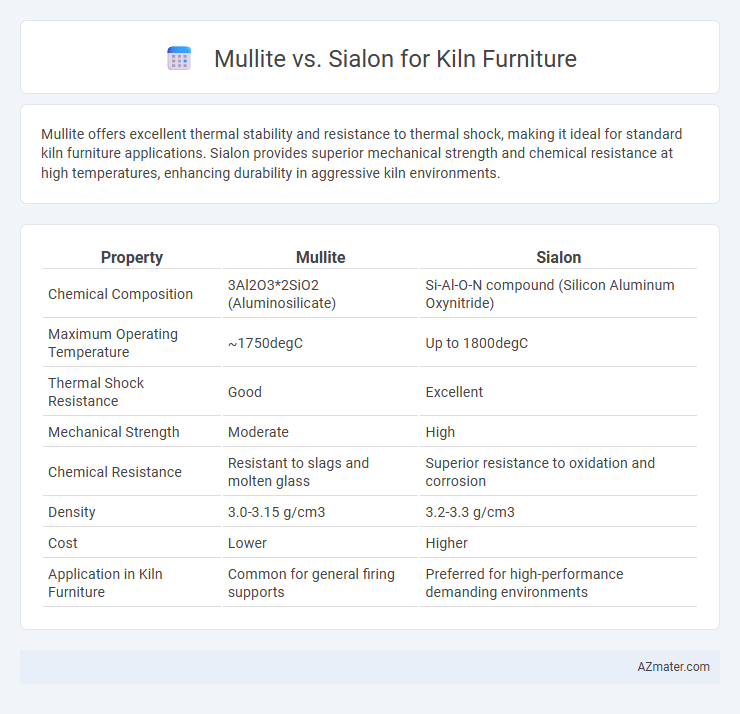Mullite offers excellent thermal stability and resistance to thermal shock, making it ideal for standard kiln furniture applications. Sialon provides superior mechanical strength and chemical resistance at high temperatures, enhancing durability in aggressive kiln environments.
Table of Comparison
| Property | Mullite | Sialon |
|---|---|---|
| Chemical Composition | 3Al2O3*2SiO2 (Aluminosilicate) | Si-Al-O-N compound (Silicon Aluminum Oxynitride) |
| Maximum Operating Temperature | ~1750degC | Up to 1800degC |
| Thermal Shock Resistance | Good | Excellent |
| Mechanical Strength | Moderate | High |
| Chemical Resistance | Resistant to slags and molten glass | Superior resistance to oxidation and corrosion |
| Density | 3.0-3.15 g/cm3 | 3.2-3.3 g/cm3 |
| Cost | Lower | Higher |
| Application in Kiln Furniture | Common for general firing supports | Preferred for high-performance demanding environments |
Introduction to Kiln Furniture Materials
Mullite and Sialon are two advanced ceramic materials commonly used in kiln furniture due to their high thermal stability and mechanical strength. Mullite offers excellent resistance to thermal shock and chemical corrosion, making it ideal for high-temperature firing processes in ceramics and glass industries. Sialon provides superior fracture toughness and creep resistance, enhancing durability and lifespan in demanding kiln environments where prolonged exposure to extreme heat is required.
Overview of Mullite Properties
Mullite exhibits exceptional thermal stability with a melting point around 1840degC and low thermal expansion, making it ideal for kiln furniture applications. Its excellent resistance to chemical corrosion and mechanical strength at high temperatures ensures durability during repeated firing cycles. Mullite's porous microstructure enhances thermal shock resistance, contributing to long service life in demanding kiln environments.
Overview of Sialon Properties
Sialon ceramics exhibit exceptional high-temperature strength, thermal shock resistance, and chemical stability, making them ideal for demanding kiln furniture applications. Their low thermal expansion and superior wear resistance enable prolonged service life in harsh kiln environments compared to mullite. Enhanced mechanical properties and resistance to creep at temperatures exceeding 1400degC distinguish Sialon as a premium material for high-performance kiln supports.
Thermal Performance: Mullite vs Sialon
Mullite exhibits excellent thermal stability with a melting point around 1840degC and moderate thermal conductivity, making it suitable for kiln furniture operating at high temperatures but requiring careful thermal shock management. Sialon ceramics offer superior thermal shock resistance and higher fracture toughness due to their unique silicate-aluminum-oxynitride microstructure, maintaining strength at temperatures exceeding 1600degC. The superior thermal performance of Sialon, including lower thermal expansion and better mechanical integrity under rapid temperature changes, often surpasses Mullite in demanding kiln environments.
Mechanical Strength Comparison
Mullite kiln furniture offers high mechanical strength with excellent resistance to thermal shock and spalling, typically maintaining structural integrity up to temperatures around 1750degC. Sialon, a silicon-aluminum-oxynitride ceramic, surpasses mullite in mechanical strength, displaying superior fracture toughness and higher flexural strength, often exceeding 400 MPa at elevated temperatures. The enhanced mechanical properties of Sialon contribute to longer service life and reduced deformation under load, making it a preferred choice for high-performance kiln furniture applications.
Chemical Resistance in High-Temperature Environments
Mullite offers excellent chemical resistance to alkalis and slags in high-temperature kiln environments, maintaining structural integrity up to around 1750degC. Sialon, a silicon-aluminum-oxynitride ceramic, demonstrates superior resistance to acidic gases and thermal shock, with stable performance beyond 1800degC. Both materials exhibit low reactivity, but Sialon's enhanced toughness and resistance to oxidation provide a significant advantage in aggressive chemical atmospheres encountered in advanced kiln furniture applications.
Lifespan and Durability in Kiln Applications
Mullite exhibits excellent thermal stability and resistance to thermal shock, delivering a lifespan of up to 5,000 firing cycles in kiln furniture applications. Sialon, composed of silicon, aluminum, oxygen, and nitrogen, offers superior mechanical strength and corrosion resistance, often extending kiln furniture durability beyond 7,000 firing cycles under harsh kiln atmospheres. The enhanced toughness and resistance to creep make Sialon a preferred choice for high-temperature kiln components requiring prolonged service life and minimal maintenance.
Cost Effectiveness and Availability
Mullite kiln furniture offers superior cost-effectiveness due to its lower raw material and manufacturing expenses compared to Sialon, making it a preferred choice for budget-conscious operations. Sialon, while more expensive, provides enhanced thermal shock resistance and longer service life, potentially reducing replacement frequency despite higher upfront costs. Availability of Mullite is widespread and consistent, ensuring easier procurement, whereas Sialon's specialized production can lead to limited availability and longer lead times in some markets.
Typical Industrial Applications
Mullite kiln furniture is widely used in ceramic and glass industries due to its excellent thermal shock resistance and stability at temperatures up to 1750degC, making it ideal for heavy-duty firing cycles and large batch sizes. Sialon kiln furniture, offering superior mechanical strength and resistance to corrosion and oxidation at temperatures exceeding 1800degC, is preferred in advanced technical ceramics and high-performance materials processing. Both materials support industrial applications such as heat treatment furnaces, sintering processes, and continuous production environments, with Sialon providing enhanced longevity and efficiency in more demanding conditions.
Choosing the Right Material for Your Kiln Furniture
Mullite kiln furniture offers excellent thermal stability and cost-effectiveness, ideal for general high-temperature applications up to 1750degC. Sialon provides superior strength, thermal shock resistance, and corrosion resistance, making it suitable for more demanding environments exceeding 1800degC. Selecting between Mullite and Sialon depends on factors such as maximum operating temperature, mechanical load, and budget constraints, ensuring optimal performance and longevity of kiln furniture.

Infographic: Mullite vs Sialon for Kiln Furniture
 azmater.com
azmater.com